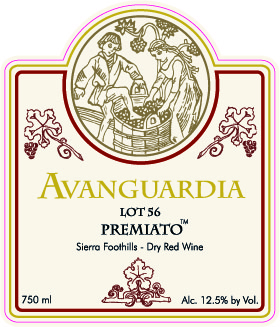|
|

theCompass mobile application is a winery, brewery, and distillery locator for North America. |
|
|
Avanguardia Wines

|
|
Avanguardia Wines blends over twenty Italian, Russian, French and University of California created crosses from its estate vineyards to craft unique and prize winning wines. Many of the grape varieties have been imported by the University especially for us and are available nowhere else, outside of Europe.
Specializing in premium blends from rare and unusual grape varieties, we rely on the tradition of selecting grapes for their synergy of flavors and tastes while using creative selections in our blending. From the crisp, racy minerality of our dry white blend, Selvatico, with grapes from the far north of Italy and the southern island of Ischia, to the generous depth of Ampio, our dry red blend of Refosco and Carmine, our wines are designed to complement fine cuisine and provide new and unique tastes for your wine drinking pleasure. Try the range of our seven proprietary blends and you taste why we are on the cutting edge of the blending craft.
|
|
|
Directions
View Map
|
View Weather
Ampio
Varietal Composition: About 50% Refosco and 50% Carmine. Refosco is an indigenous red variety from Friuli (NE Italy) with deep color and plum or cranberry fruit; Carmine is a University of California two-generation cross: Carignane X Cabernet Sauvignon crossed again with Merlot. Carmine is also dark, with somewhat intense flavors.
What it resembles: Italian style Merlot from Collio, Meritage blends from Cabernet and Merlot.
|
Cara Mia Rosato
Our first rose type wine, the Cara Mia Rosato is made from Sangiovese and other red varieties vinified as for a white wine. Cara Mia has a miniscule amount of residual sugar ( approx. 0.5%) which for many will still leave a dry impression on the palate. Compares favorably with Provence rose wines.
|
Cristallo
Varietal Composition: The dominant grape in our Cristallo blend is the Georgian Rkatsiteli, widely planted in eastern Europe. A grape of very high quality, its wines are seldom exported. We combine it ( at about 70-90%) with Pinot Blanc, Pinot Grigio and Melon de Bourgogne. Melon is the sole variety in the Loire wine known as Muscadet, sometimes referred to as the quintessential “oyster wine”.
What it resembles: This is our most unique wine and is hard to pin down a similar wine made by others. Some have said it’s like a Riesling/Gewurztraminer blend. It is dry, crisp, taut, and relatively full-bodied; fruit tends towards apples, pears, and sometimes more exotic fruits. Can acquire a Burgundian quality to the finish after some time in bottle.
|
Due Fiori
Varietal Composition: About 40% Semillon, 30-40% Flora, 20-25% Chenin Blanc, and the balance Orange Muscat (also known as Moscato Fior d’Arancio in Italy).
Flora is a cross of Gewurztraminer and Semillon made by Dr. Olmo of University of Calif, Davis in 1958, and the name means flower in Latin; the second flower in the wine name is the Moscato, hence the name Due Fiori (Two Flowers).
What it resembles: The classic Semillon blends are with Sauvignon Blanc, where Semillon provides body; we take a different path. Imagine good dry Semillon, as from the Southern Hemisphere, plus dry Gewurztraminer, plus dry but fruity Chenin Blanc, topped off with exotic citrus notes from Orange Muscat. Dry though, not sweet.
|
Premiato
Varietal Composition: Predominantly Barbera (60-70%), with the balance mostly Dolcetto; occasional additions of complementary varieties. Both Barbera and Dolcetto are varieties native to the Italian Piedmont in the Northwest.
What it resembles: Barberas made in a softer style, or blended with Petite Sirah, other varieties, especially those with fatter or more luscious flavor profiles and/or lower acidities.
|
Sangineto
Varietal Composition: At least 75% ( i.e. could be a varietal) Sangiovese, plus the patented UC cross Carmine ( see Ampio for description) and possibly other varieties to add color, body. Three clones of Sangiovese, including the Brunello clone are used.
What it resembles: Various Tuscan Sangiovese blends, sometimes known as Super-Tuscans. Picked at less than 25% sugar, this wine is more restrained and displays more finesse than many California Sangioveses or Sangiovese blends.
|
Selvatico
Varietal Composition: Tocai Friulano at about 50%, with significant fractions of Peverella and Forastera; small additions of Pinot Grigio, Sauvignon, or Melon de Bourgogne may be included.
Peverella is from the Trentino area in north-central Italy and is grown in the foothills of the Alps, ideally adapting it to our Sierra Foothill environs; low pH and good acidity with unique but unobtrusive varietal character. Personal research indicates it may actually be a clone of the better known variety Verdicchio.
Forastera is an island grape in Italy and is responsible for at least half of the wine known as Ischia Bianco Superiore on the island of Ischia just south of Capri. Forastera has nice mineral notes on the finish.
What it resembles: High-end Italian Pinot Grigio from the Collio region in Friuli, or some of the so-called Super-Friulians, expensive multi-variety white blends, also from Collio.
|
Add New Review
|
|